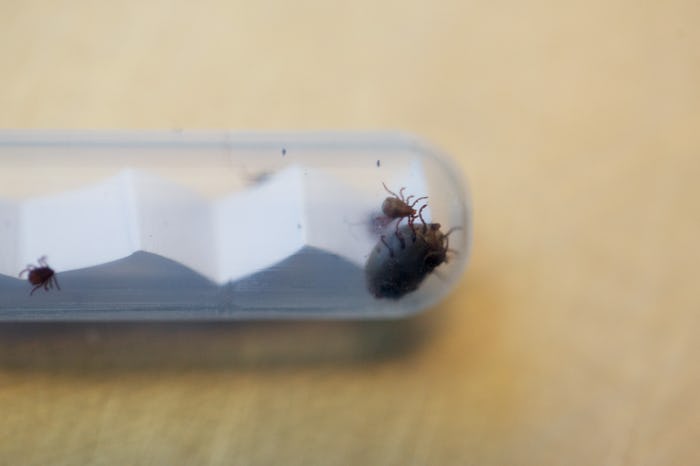Life

There's Actually An Exact Way To Dispose Of A Tick, & It's Super Important
Even if you aren't particularly bothered by creepy crawlies, removing a tick burrowing into your child's (or your own!) skin can make the toughest moms shudder. Luckily, these bugs are typically peskier than they are dangerous, but they should always be removed promptly and carefully. Spotting and extricating a tick is half the battle, but it's important to know what to do with a tick after removal as well. You might be surprised to know there's actually a method to disposing of these critters — and no, it's not just clobbering them with your heaviest shoe.
Before you worry about disposing of the tick, make absolutely sure you've gotten the entire thing out of the skin. According to the Centers for Disease Control and Prevention (CDC), the best way to ensure that you get the whole thing is by using fine-tipped tweezers to grab and pull the tick with a steady hand. Try your best to get it all in one fell swoop, minimizing the risk that the bug will break and leave bits behind. Gross, right?
After you're confident the tick has been removed, Reader's Digest reports you'll need to clean your hands and the area with soapy water or rubbing alcohol. Although, after seeing an insect clinging to your bare skin — yuck — I probably don't have to tell you to wash off. A good scrubbing will help prevent illness or infection, and probably make you feel less queasy.
Now comes the fun part: exacting revenge on the bug that tried to make your skin, or your child's skin, its new home.
Resist the temptation to squash it like you might any other bug. According to Reader's Digest, if a tick is carrying diseases, breaking it can cause the disease to spread. Instead, drop the entire thing in the toilet and give it a flush. So long.
Want to be extra careful? Reader's Digest suggests preserving the tick so that, if the worst case scenario occurs, your doctor can inspect it. Drop it in a jar or a sandwich baggie, or even tape it onto an index card like an amateur entomologist. Jot down the day you found it — and where you think it came from — so you'll have any information that may be helpful in the future.
In the following days and weeks, pay attention to the site you found the tick and how you're feeling. According to the CDC, you should see a doctor if you develop a fever or a rash within a few weeks. There are numerous different tick-borne illnesses, and knowing the time and place of the tick bite can be useful information for your medical provider.
Of course, the safest thing you can do for yourself and your family is to prevent tick bites in the first place. Reader's Digest suggests several methods for reducing your tick risks, like spraying everyone down with a good bug spray containing DEET. When you're spending a lot of time outside, make it a habit to examine yourself and your little ones from top to bottom — particularly in hiding spots like the underside of arms and even in the belly button. Shower soon after coming inside to help spot and wash off any ticks, and dry your clothes on high heat to kill any stuck on the fabric. Don't forget to pop a tick-repelling collar on your family pet to prevent ticks from getting into your home, and regularly examine them for the insects, too.
So don't freak out if you or your child has been bitten by a tick. Remove it carefully, dispose of it properly, and odds are you'll be totally fine. A little grossed out, definitely, but fine.